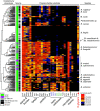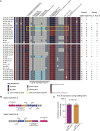Phenotypic and Genomic Diversification in Complex Carbohydrate-Degrading Human Gut Bacteria
- PMID: 35166563
- PMCID: PMC8845570
- DOI: 10.1128/msystems.00947-21
Phenotypic and Genomic Diversification in Complex Carbohydrate-Degrading Human Gut Bacteria
Abstract
Symbiotic bacteria are responsible for the majority of complex carbohydrate digestion in the human colon. Since the identities and amounts of dietary polysaccharides directly impact the gut microbiota, determining which microorganisms consume specific nutrients is central for defining the relationship between diet and gut microbial ecology. Using a custom phenotyping array, we determined carbohydrate utilization profiles for 354 members of the Bacteroidetes, a dominant saccharolytic phylum. There was wide variation in the numbers and types of substrates degraded by individual bacteria, but phenotype-based clustering grouped members of the same species indicating that each species performs characteristic roles. The ability to utilize dietary polysaccharides and endogenous mucin glycans was negatively correlated, suggesting exclusion between these niches. By analyzing related Bacteroides ovatus/Bacteroides xylanisolvens strains that vary in their ability to utilize mucin glycans, we addressed whether gene clusters that confer this complex, multilocus trait are being gained or lost in individual strains. Pangenome reconstruction of these strains revealed a remarkably mosaic architecture in which genes involved in polysaccharide metabolism are highly variable and bioinformatics data provide evidence of interspecies gene transfer that might explain this genomic heterogeneity. Global transcriptomic analyses suggest that the ability to utilize mucin has been lost in some lineages of B. ovatus and B. xylanisolvens, which harbor residual gene clusters that are involved in mucin utilization by strains that still actively express this phenotype. Our data provide insight into the breadth and complexity of carbohydrate metabolism in the microbiome and the underlying genomic events that shape these behaviors. IMPORTANCE Nonharmful bacteria are the primary microbial symbionts that inhabit the human gastrointestinal tract. These bacteria play many beneficial roles and in some cases can modify disease states, making it important to understand which nutrients sustain specific lineages. This knowledge will in turn lead to strategies to intentionally manipulate the gut microbial ecosystem. We designed a scalable, high-throughput platform for measuring the ability of gut bacteria to utilize polysaccharides, of which many are derived from dietary fiber sources that can be manipulated easily. Our results provide paths to expand phenotypic surveys of more diverse gut bacteria to understand their functions and also to leverage dietary fibers to alter the physiology of the gut microbial community.
Keywords: Bacteroides; microbiome; pangenome; polysaccharides.
Conflict of interest statement
The authors declare no conflict of interest.
We declare no competing interests.
Figures







Comment in
-
Mind the Gap: Bridging the Divide from Sequencing Data to Empiric Phenotypes in the Human Gut Microbiota.mSystems. 2022 Jun 28;7(3):e0020722. doi: 10.1128/msystems.00207-22. Epub 2022 Jun 13. mSystems. 2022. PMID: 35695430 Free PMC article.
Similar articles
-
Symbiotic Human Gut Bacteria with Variable Metabolic Priorities for Host Mucosal Glycans.mBio. 2015 Nov 10;6(6):e01282-15. doi: 10.1128/mBio.01282-15. mBio. 2015. PMID: 26556271 Free PMC article.
-
Reciprocal Prioritization to Dietary Glycans by Gut Bacteria in a Competitive Environment Promotes Stable Coexistence.mBio. 2017 Oct 10;8(5):e01068-17. doi: 10.1128/mBio.01068-17. mBio. 2017. PMID: 29018117 Free PMC article.
-
The devil lies in the details: how variations in polysaccharide fine-structure impact the physiology and evolution of gut microbes.J Mol Biol. 2014 Nov 25;426(23):3851-65. doi: 10.1016/j.jmb.2014.06.022. Epub 2014 Jul 12. J Mol Biol. 2014. PMID: 25026064 Free PMC article. Review.
-
Recognition and degradation of plant cell wall polysaccharides by two human gut symbionts.PLoS Biol. 2011 Dec;9(12):e1001221. doi: 10.1371/journal.pbio.1001221. Epub 2011 Dec 20. PLoS Biol. 2011. PMID: 22205877 Free PMC article.
-
Carbohydrates great and small, from dietary fiber to sialic acids: How glycans influence the gut microbiome and affect human health.Gut Microbes. 2021 Jan-Dec;13(1):1-18. doi: 10.1080/19490976.2020.1869502. Gut Microbes. 2021. PMID: 33615984 Free PMC article. Review.
Cited by
-
Unraveling the Metabolic Requirements of the Gut Commensal Bacteroides ovatus.Front Microbiol. 2021 Nov 25;12:745469. doi: 10.3389/fmicb.2021.745469. eCollection 2021. Front Microbiol. 2021. PMID: 34899632 Free PMC article.
-
Comprehensive analyses of a large human gut Bacteroidales culture collection reveal species- and strain-level diversity and evolution.Cell Host Microbe. 2024 Oct 9;32(10):1853-1867.e5. doi: 10.1016/j.chom.2024.08.016. Epub 2024 Sep 17. Cell Host Microbe. 2024. PMID: 39293438
-
Seminars in immunology special issue: Nutrition, microbiota and immunity The unexplored microbes in health and disease.Semin Immunol. 2023 Mar;66:101735. doi: 10.1016/j.smim.2023.101735. Epub 2023 Feb 27. Semin Immunol. 2023. PMID: 36857892 Free PMC article. Review.
-
Propionate production by Bacteroidia gut bacteria and its dependence on substrate concentrations differs among species.Biotechnol Biofuels Bioprod. 2024 Jul 10;17(1):95. doi: 10.1186/s13068-024-02539-9. Biotechnol Biofuels Bioprod. 2024. PMID: 38987848 Free PMC article.
-
Broad host range may be a key to long-term persistence of bacteriophages infecting intestinal Bacteroidaceae species.Sci Rep. 2022 Dec 6;12(1):21098. doi: 10.1038/s41598-022-25636-x. Sci Rep. 2022. PMID: 36473906 Free PMC article.
References
Publication types
MeSH terms
Substances
Supplementary concepts
Grants and funding
LinkOut - more resources
Full Text Sources
Molecular Biology Databases

